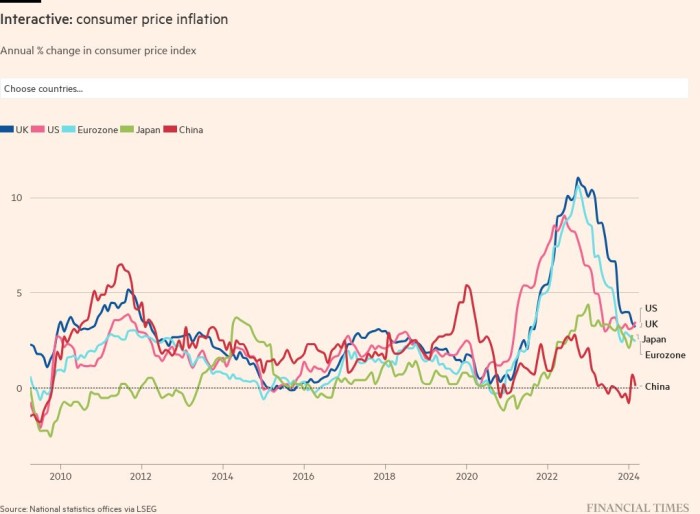A sequence of massive charge hikes by the Federal Reserve has put strain on central banks all over the world to do the identical and counter hovering inflation and a powerful greenback.
A Monetary Occasions evaluation discovered that central banks now, greater than at any time this century, they’re choosing massive charge hikes of fifty foundation factors or extra, exposing the challenges of addressing worth pressures and better US charges.
The Fed’s hikes, together with its first 75 foundation level hike since 1994, and fears concerning the well being of the worldwide economic system have buoyed the US greenback in opposition to virtually all currencies. Since many items are priced in {dollars} on worldwide markets, the energy of the greenback provides to inflationary pressures by elevating the price of imports, creating what analysts have described as a “reverse foreign money warfare” between policymakers. financial coverage.
“We’re seeing a frenzy fueled by charge hikes,” mentioned James Athey, senior portfolio supervisor at Abrdn, an funding firm. “It is the alternative of what we have seen within the final decade. . . As we speak, the very last thing anybody desires is a weak foreign money.”
Canadian lawmakers turned the newest to shock markets with a larger-than-expected hike, choosing a 100 foundation level hike on Wednesday, the biggest of any G7 economic system since 1998. The Philippines raised charges by 75 foundation factors on subsequent day.
Within the three months to June, the 55 central banks tracked by the Monetary Occasions made 62 coverage charge hikes of not less than 50 foundation factors. There have been one other 17 massive charge hikes of fifty foundation factors or extra up to now, marking essentially the most massive charge strikes at any time for the reason that flip of the millennium and dwarfing the newest international financial tightening cycle, which was underway. . -until the worldwide monetary disaster.
“We have seen this tipping level out there the place 50 is the brand new 25,” mentioned Jane Foley, head of overseas alternate technique at Rabobank.
Central banks in nations extremely uncovered to overseas alternate market strain have raised charges by significantly massive quantities. Hungary stands out, with its key coverage charge raised 385 foundation factors in simply two months, because the nation faces inflation and a foreign money depreciation in opposition to the greenback at double-digit charges.
The alternate charge element is vital in making financial coverage selections for a lot of rising markets, mentioned Jennifer McKeown, director of the worldwide economics service at Capital Economics. They included a number of rising European economies whose currencies had been hit by issues concerning the Ukraine warfare, in addition to a normal risk-averse setting, she mentioned.
However the development is widespread and has additionally affected the central banks of the richest nations. South Korea’s central financial institution made its first 50 foundation level hike in July.
Lots of the large strikes have misled traders, together with in Australia, Norway and Switzerland, the place the central financial institution made an surprising 50 foundation level hike in June. Markets had forecast that the historically dovish Swiss Nationwide Financial institution would wait till later within the 12 months to lift charges, however issues about inflation and the alternate charge prompted authorities to behave sooner.
In most superior economies, charges are rising from file lows following aggressive easing by central banks in the course of the early months of the Covid-19 pandemic. With charges nonetheless low by historic requirements, economists count on a number of main central banks to lift charges by 50 foundation factors or 75 bps at their upcoming rate-setting conferences to deliver borrowing prices nearer to long-term averages. time period.
McKeown mentioned central banks wanted to maneuver shortly to maneuver charges out of “stimulant” territory, “significantly in an setting the place wage progress and inflation expectations are rising and there’s a danger that inaction will enable spirals to unfold.” of wages and costs.
The Financial institution of England and the European Central Financial institution have but to make such massive charge hikes. Nonetheless, Matthew Ryan, senior market analyst at international monetary providers agency Ebury, mentioned the BoE “will most likely have to affix the ’50s membership’ to raise sterling from its present repressed ranges.”
The euro reached parity with the greenback this week, however the ECB, which meets on July 21, is predicted to lift charges by a extra modest 25 foundation factors.
Robust jobs knowledge and higher-than-expected inflation in June have bolstered expectations of one other large charge hike by the Federal Reserve at its subsequent assembly on July 27. the goal vary for federal funds to achieve between 3.5 % and three.75 % by the tip of the 12 months.
The Fed’s further hikes will put strain on many rising markets to catch up, regardless that many started tightening financial insurance policies final 12 months, forward of superior economies.
Agustín Carstens, director normal of the Financial institution for Worldwide Settlements, advised a current convention organized by the ECB that rising markets had “realized the teachings” from earlier US tightening cycles. He mentioned that whereas historically rising markets would increase rates of interest after their counterparts in superior economies, “now they began very early and what you possibly can see is that they’ve managed to maintain their alternate charges pretty steady.”

